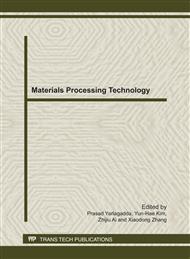p.184
p.188
p.192
p.198
p.203
p.209
p.214
p.219
p.225
Time-Varying Characteristics of Bending Deformation of Work-Piece in the Turning Process
Abstract:
Based on the geometrical description of work-pieces cutting process, the time-varying differential equations of deflection curve under two different conditions were obtained using the singular function: one with thimble and one without thimble constraint. Using the Mathcad software, we have solved the time-varying differential equations analytically and have studied the deflection changing of work piece with the position of turning tool and given the distribution characteristic for the time-varying deflection of each section. The results indicate that (1) the deflection of an arbitrary section is time-varying due to the time-varying position of the turning tool and the time-varying inertia moment; (2) for the shaft with thimble constraint, the position of the maximal deflection is not at the section with turning tool; (3) for the shaft without thimble constraint, when the turning tool is at the free end, the deflection at each section of the work-piece is the maximal compared with the other positions of turning tool.
Info:
Periodical:
Pages:
203-208
Citation:
Online since:
September 2011
Authors:
Price:
Сopyright:
© 2011 Trans Tech Publications Ltd. All Rights Reserved
Share:
Citation:


